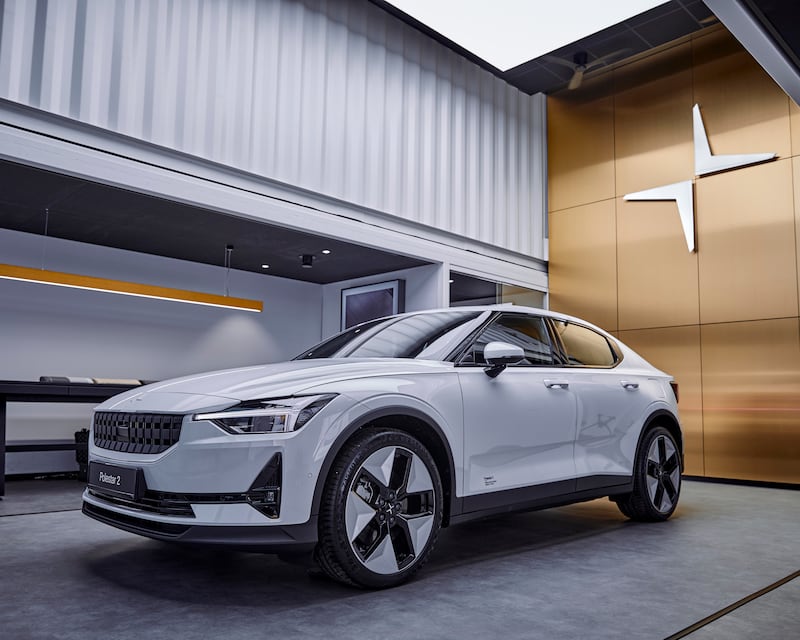Launching a luxury car brand, direct to consumers, online, is the challenging trifecta being driven by Polestar Ireland.
The Swedish electric performance car brand, which is owned by Volvo — which in turn is owned by China’s Geely — arrived in Ireland in March 2022, with the launch of the Polestar 2, positioned as a premium EV.
With avant-garde styling and advanced technology, it would help drive Ireland’s transition to electric vehicles.
At the time Kieran Campbell, market lead for Polestar Ireland, said there was a huge appetite for new premium electric cars here, so its arrival couldn’t be better timed.
‘A gas emergency would quickly turn into an electricity emergency. It is low-risk, but high-consequence’
How LEO Digital for Business is helping to boost small business competitiveness
‘I have to believe that this situation is not forever’: stress mounts in homeless parents and children living in claustrophobic one-room accommodation
Unlocking the potential of your small business
But just as innovative as the car itself is its innovative sales and marketing strategy, explains Campbell in the latest episode of industry-focused podcast Inside Marketing.
For a start, Polestar cars are purchased in an entirely new way, online through a simplified 100 per cent digital process. Instead of a traditional dealer network, the marque complements its offer with bespoke physical locations known as Polestar spaces or destinations.
These provide an immersive experience to would-be buyers. They’re designed to allow consumers to interact physically with the brand, meet with Polestar specialists to explore the car in more detail, and then take the car for a test drive solo.
The brand follows the same marketing playbook globally.
The company plans to have a line-up of five performance EVs by 2026. Polestar 2, the electric performance fastback, launched in 2019. Polestar 3, an SUV, launched in late 2022. Polestar 4, an SUV coupe, is launching in phases through 2023 and 2024. Polestar 5, an electric four-door GT and Polestar 6, an electric roadster, will follow.
All are part of Polestar 0, the company’s goal of creating a car that by 2030 will be fabricated using a climate-neutral production process.
Despite its electric pedigree, the central thrust of its marketing is neither the environment, nor that it is electric, but how it drives, says Campbell.

Fuelling the right media mix
Despite being a disruptive digital-first brand, traditional media channels are an important lever to help establish and build Polestar’s brand awareness. It uses a mix that includes TV, AV, print and out-of-home, as well as digital media.
The company tracks awareness closely but having only established a physical presence in Ireland in October 2022, a huge part of its early promotion comes simply from having cars on the road.
“When I was first driving around in a product, everyone would stare. I was stopped all the time, which was great, because I got to tell the story lots of times but now, I don’t need to anymore, because people know it’s a Polestar,” he explains.
Among the activities undertaken to generate a buzz around the brand were live events, such as a three-day display at Weston Airport, with further animations in Malahide, Galway and Cork.
These are test drive events that people can book to experience the car. They are held in parts of the country that the company sees most online searches coming from.
The brand hasn’t chased any particular customer segment in its marketing, a wise strategy, given that its very first customer here was a couple in their 80s who chose it for its electric credentials, and to pull a caravan for touring.
“Since then we have had all ages, families with young kids, and everything in between. We don’t specifically go after one customer because then you are seen to be going after that customer base. We’re allowing people to come in out of curiosity. We also bring the cars to people’s spaces and work, for a company test or event,” he says.
Many of its customers are already into driving premium brands, which is great he says, as it establishes Polestar as a similarly premium brand they are happy to change to.
As a newbie the company also stands to benefit from the frequency illusion or so-called yellow car syndrome, the kind of cognitive bias that leads you to discover a new word, or see a certain kind of car, and then feel you are seeing it everywhere.

A good influence
As well as its test drive fleet, the company provides cars to motoring journalists and works with influencers, but only those whose “brand values need to align with our brand values,” he explains.
“It has to be very clear who we want to work with because they are essentially representing us if they are in our car. There’s a big responsibility on that person to be responsible for us as a brand and they’re going to get asked questions.”
It’s not “just a car”, he adds, such questions need “to be handled with due care and attention”.
While Polestar benefits in promotional terms from being the new kid on the block, just as Tesla did when it arrived, the latter has quickly moved to become familiar. So how does a brand make that transition from being aspirational by virtue of being new and different, to a desire that sustains?
Promoting scarcity is a well-understood way of driving demand but Polestar will not be engineering limited availability.
Instead, Campbell believes the advent of new models, at different price points, will naturally ensure interest is sustained. Polestar 2 entered the market priced from €54,000. Polestar 3 will be priced from €99,900, targeting a different segment.
Product placement so far has only played a small role. Blink and you might miss the car’s appearance in the streaming hit TV show Succession, for example.
General marketing communications are tightly controlled, with all creative coming from Gothenburg and no room for detours. “Everything we do is very specific because you get one chance to launch a premium brand in a market and it has to be the same everywhere,” he says.
The look of Polestar’s space in Sandyford is replicated in all its markets around the world. “If you were to step in another building, it would be the exact same and that’s critical,” he says.
The company maintains brand and design consistency in the same way Apple does and, like the iPhone maker, emphasises the user experience. “We focus on the driving aspect of the car,” says Campbell.
Tesla may have smoothed the road for premium electric EVs, but the Swedish company’s “aspirational brand internally is Porsche”, he says.
And although Polestar could have taken the easy route and leveraged Volvo’s brand equity in its launch, having developed its R&D and providing it with a service partnership, it didn’t.
“We’re very proud of our Volvo heritage at Polestar but we’re a completely different sales entity,” he says.
- To hear the Inside Marketing podcast click here















